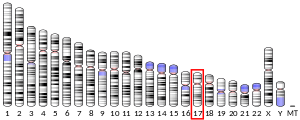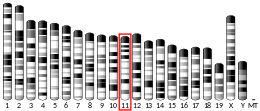TEKT1
Tektin 1 is a protein that in humans is encoded by the TEKT1 gene.[5][6]
| TEKT1 | |||||||||||||||||||||||||
|---|---|---|---|---|---|---|---|---|---|---|---|---|---|---|---|---|---|---|---|---|---|---|---|---|---|
| Identifiers | |||||||||||||||||||||||||
| Aliases | TEKT1, tektin 1 | ||||||||||||||||||||||||
| External IDs | OMIM: 609002 MGI: 1333819 HomoloGene: 7973 GeneCards: TEKT1 | ||||||||||||||||||||||||
| |||||||||||||||||||||||||
| |||||||||||||||||||||||||
| |||||||||||||||||||||||||
| Orthologs | |||||||||||||||||||||||||
| Species | Human | Mouse | |||||||||||||||||||||||
| Entrez | |||||||||||||||||||||||||
| Ensembl | |||||||||||||||||||||||||
| UniProt | |||||||||||||||||||||||||
| RefSeq (mRNA) | |||||||||||||||||||||||||
| RefSeq (protein) | |||||||||||||||||||||||||
| Location (UCSC) | Chr 17: 6.79 – 6.83 Mb | Chr 11: 72.34 – 72.36 Mb | |||||||||||||||||||||||
| PubMed search | [3] | [4] | |||||||||||||||||||||||
| Wikidata | |||||||||||||||||||||||||
| |||||||||||||||||||||||||
Function
This gene product belongs to the tektin family of proteins. Tektins comprise a family of filament-forming proteins that are coassembled with tubulins to form ciliary and flagellar microtubules. This gene is predominantly expressed in the testis and in mouse, tektin 1 mRNA was localized to the spermatocytes and round spermatids in the seminiferous tubules, indicating that it may play a role in spermatogenesis.[5]
gollark: Just cheat and bring it with you.
gollark: And I can *exit* vim.
gollark: I just know how to operate nano, it's *mostly* available.
gollark: https://www.gnu.org/fun/jokes/ed-msg.en.html
gollark: It is the standard editor.
References
- GRCh38: Ensembl release 89: ENSG00000167858 - Ensembl, May 2017
- GRCm38: Ensembl release 89: ENSMUSG00000020799 - Ensembl, May 2017
- "Human PubMed Reference:". National Center for Biotechnology Information, U.S. National Library of Medicine.
- "Mouse PubMed Reference:". National Center for Biotechnology Information, U.S. National Library of Medicine.
- "Entrez Gene: tektin 1".
- Xu M, Zhou Z, Cheng C, Zhao W, Tang R, Huang Y, Wang W, Xu J, Zeng L, Xie Y, Mao Y (December 2001). "Cloning and characterization of a novel human TEKTIN1 gene". Int. J. Biochem. Cell Biol. 33 (12): 1172–82. doi:10.1016/S1357-2725(01)00089-9. PMID 11606253.
Further reading
- Strausberg RL, Feingold EA, Grouse LH, et al. (2002). "Generation and initial analysis of more than 15,000 full-length human and mouse cDNA sequences". Proc. Natl. Acad. Sci. U.S.A. 99 (26): 16899–903. doi:10.1073/pnas.242603899. PMC 139241. PMID 12477932.
- Rose JE, Behm FM, Drgon T, et al. "Personalized smoking cessation: interactions between nicotine dose, dependence and quit-success genotype score". Mol. Med. 16 (7–8): 247–53. doi:10.2119/molmed.2009.00159. PMC 2896464. PMID 20379614.
- Newby PR, Pickles OJ, Mazumdar S, et al. (2010). "Follow-up of potential novel Graves' disease susceptibility loci, identified in the UK WTCCC genome-wide nonsynonymous SNP study". Eur. J. Hum. Genet. 18 (9): 1021–6. doi:10.1038/ejhg.2010.55. PMC 2987410. PMID 20442750.
- Gerhard DS, Wagner L, Feingold EA, et al. (2004). "The status, quality, and expansion of the NIH full-length cDNA project: the Mammalian Gene Collection (MGC)". Genome Res. 14 (10B): 2121–7. doi:10.1101/gr.2596504. PMC 528928. PMID 15489334.
- Iguchi N, Tanaka H, Nakamura Y, et al. (2002). "Cloning and characterization of the human tektin-t gene". Mol. Hum. Reprod. 8 (6): 525–30. doi:10.1093/molehr/8.6.525. PMID 12029069.
This article incorporates text from the United States National Library of Medicine, which is in the public domain.
This article is issued from Wikipedia. The text is licensed under Creative Commons - Attribution - Sharealike. Additional terms may apply for the media files.



